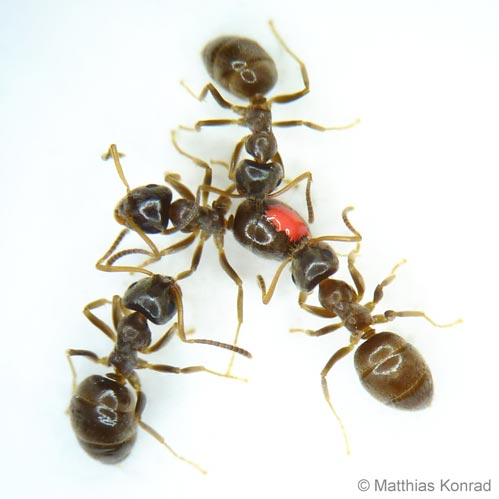April 4, 2012
Micro-infections promote social vaccination in ant societies
Group of IST Professor Sylvia Cremer uncovers how social contact to sick ants leads to an immune protection in their nestmates

In their research article “Social Transfer of Pathogenic Fungus Promotes Active Immunisation in Ant Colonies”, published April 3 in the online, open-access journal PLoS Biology, the research team of Prof. Sylvia Cremer at the Institute of Science and Technology Austria (IST Austria) show how micro-infections promote Social Vaccination in ant societies. Like crowded megacities, ant colonies face a high risk of disease outbreaks. These are kept in check by the ants’ “social immune system”— a set of collective hygienic behaviors and adaptive changes in interaction frequencies that acts in conjunction with the physiological, innate immune system of colony members. Prof. Cremer and colleagues now unravel how taking care of sick ants promotes disease protection in their group members. They also discuss their findings in the latest edition of the PLoS Podcast.
Ants do not avoid sick colony members, but lick them to remove the pathogen from the exposed ant’s body. This social grooming behavior drastically increases the survival chances of exposed individuals, but bares the risk that helper ants contract the disease. By applying fluorescence-labelled fungal spores to some ants and allowing them to interact with healthy colony members, the researchers showed that the labelled spores spread throughout the colony. Interestingly, however, spore transfer occurs at very low levels, causing only sub-lethal micro-infections in the previously healthy colony members. The authors determined that these low-level infections induce the expression of a specific set of immune genes and increase the ants’ capacity to fight the fungal pathogen. Additional mathematical modelling suggests that such social immunisation enables colonies to recover more rapidly from an infection.
Social low-level spread of infectious particles therefore constitutes the underlying mechanism of social immunisation against fungal infections in ant societies. This is nature’s counterpart to the first human efforts in inducing immunity against deadly diseases like smallpox. At a time when vaccination with dead or attenuated strains was not yet invented, immunity was induced in people by actively transferring low-level infections through so-called variolation. The extent of any human implications is not yet clear, but this study allows for informed inferrences to be made for a wider context.
As Simon Babyan from Edinburgh University and David Schneider from Stanford note in an accompanying primer article also published in PLoS Biology, “The authors used a combination of approaches to identify the mechanisms underlying social immunisation in ant colonies: mathematical modelling, behavioural, microbiological, immunological and molecular techniques, which, taken together, offer an exciting proof-of-concept that group-level immunity may be experimentally manipulated and modelled (…) By studying social immunity at a system level in insects perhaps we can find emergent properties that we have been missing in another important social animal—the human.”
The entire research article can be found on the PLoS Biology website.



